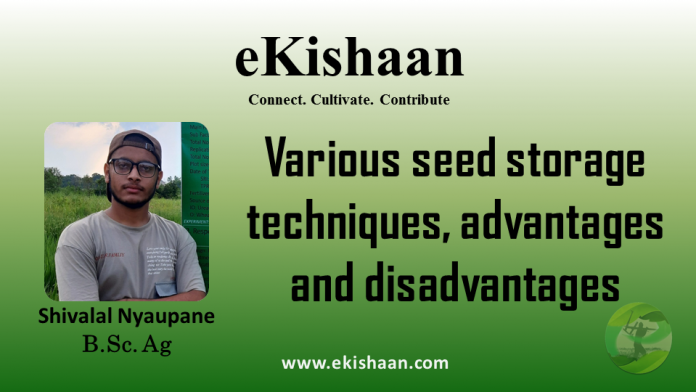Various seed storage techniques,advantages and disadvantages
Seed storage generally known to be preservation of the viable seeds for future sowing.Research shows that about 20-30% of total production is lost in Post harvest Handling, and Storage comprises its significant contribution. Different types of storage system and practices has been followed from the past and with the advancement of technology, it will be going. In this race, we should know why it is done? How are we doing? And what can be a future possibility?
There are various traditional practices of seed storage in order to protect the seeds from the storage pest,pathogens and several diseases. The seeds can be stored in traditional structure such as bhakari, deri, tanks, kothar, morai etc. The people of rural areas use traditional methods as there were no proper modern facilities.
Storage places in the case of Nepal that are followed traditionally are,
Bhakari
This is the structure found in the village in their storage room. These structures are bounded by a bamboo mat with mud plastering . They are used to store rice typically. Paddy is threshed, harvested, and stored in these structures from where rice is being used throughout the year.
On the rooftop Floor “ Buikal”:
This kind of technique is used for the storage of maize, potato, and other grains. Here the seeds are harvested and stored on the rooftop. Prior to settling the grains, they are processed and while storing they are treated with different homemade and traditional ways which are most common as materials are easily available.
Separate House For Storage:
A mostly used technique where separate house small type is made and the whole harvest is stored along with before mentioned ways for repelling insect and pests.
Home made and traditional ways of storage are,
- Sun drying of grains,
- Use of ash,
- Storage of pulses with common salt,
- Turmeric application method,
- Use of garlic cloves,
- Mixing of leaves,
- Use of salt and chilli powder,
- Use of Neem (Margosa) leaves,
- Use of Neem (Margosa)leaves and dry chillies,
- Use of Neem Oil /Margosa oil,
- Use of camphor,
- Sand mixture method,
- Use of dried red chillies,
- Use of lime powder,
- Use of matchbox,
- Fumigation of the godown /store rooms,
- Use of Neem (Margosa) seed powder,
- Use of ginger rhizome,
- Use of Tulsi (basil) seeds.
Importance of traditional seed storage practices in comparison to modern structures and technique;
- Not much more storage cost,
- The resources required were easily available,
- The storage structure were made as the part of house so not more problem of space,
- Not more technical knowledge is needed.
Disadvantages of indigenous storage
- No longer storage life of the seeds,
- Quantity of seed that can be stored is low,
- As comparison to modern techniques incidence of disease and pest is high,
- Quality of seed.
Modern storage:
To improve the storage technique of the seeds and grains,modern storage techniques were adopted which includes the most advanced and well-equipped ways of storage. It includes storage on Cold storage, Zero energy storage, and sophisticated methods. Metal bins and hermetic ‘super grain bags ‘ (SGB) are also used. At seed banks seeds stored to preserve genetic diversity. Seeds are dried to optimum moisture content, evaluated for quality and genetic purity, and sealed in moisture-proof containers. For short storage, seeds are dried and placed in sealed containers at 5 degrees celsius. They are stored at a temperature below freezing for long term preservation.
Advantages
- Good quality seeds,
- Large quantity can be stored,
- Seed quality
- More storage life.
Disadvantages
- High cost,
- Requirement of basic knowledge and skills,
- Products are not easily available,
- High cost of seeds stored in controlled environment which cause difficulty in purchasing the seeds for farmers.

